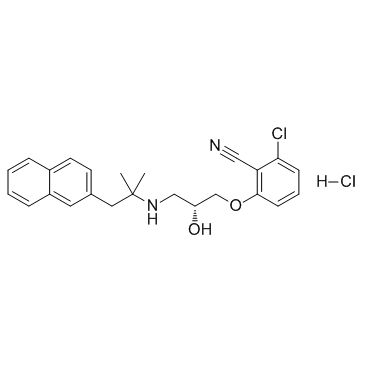NPS-2143 hydrochloride

NPS-2143 hydrochloride structure
|
Common Name | NPS-2143 hydrochloride | ||
|---|---|---|---|---|
| CAS Number | 324523-20-8 | Molecular Weight | 445.381 | |
| Density | N/A | Boiling Point | N/A | |
| Molecular Formula | C24H26Cl2N2O2 | Melting Point | N/A | |
| MSDS | Chinese USA | Flash Point | N/A | |
| Symbol |


GHS07, GHS09 |
Signal Word | Warning | |
Use of NPS-2143 hydrochlorideNPS-2143(SB 262470A ) is a selective potent calcium ion-sensing receptor antagonist with IC50 of 43 and 41 nM for cytoplasmic Ca2+ concentrations and parathyroid hormone secretion, respectively.IC50 value: 43 nM(for Ca2+ receptor) [1]Target: CaSRin vitro: NPS 2143, even when tested at much higher concentrations (3 microM), did not affect the activity of a number of other G protein-coupled receptors, including those most structurally homologous to the Ca2+ receptor. NPS 2143 stimulated parathyroid hormone (PTH) secretion from bovine parathyroid cells (EC50 of 41 nM) over a range of extracellular Ca2+ concentrations and reversed the effects of the calcimimetic compound NPS R-467 on [Ca2+]i and on secretion of PTH [1]. The first reported calcilytic compound was NPS 2143, an orally active molecule which elicits rapid, 3- to 4-fold increases in circulating levels of PTH [2].in vivo: When infused intravenously in normal rats, NPS 2143 caused a rapid and large increase in plasma levels of PTH. Ca2+ receptor antagonists are termed calcilytics and NPS 2143 is the first substance (either atomic or molecular) shown to possess such activity [1]. When administered together with an antiresorptive agent (estradiol), NPS 2143 causes an increase in trabecular bone volume and bone mineral density in osteopenic rats [2]. |
| Name | NPS-2143 hydrochloride |
|---|---|
| Synonym | More Synonyms |
| Description | NPS-2143(SB 262470A ) is a selective potent calcium ion-sensing receptor antagonist with IC50 of 43 and 41 nM for cytoplasmic Ca2+ concentrations and parathyroid hormone secretion, respectively.IC50 value: 43 nM(for Ca2+ receptor) [1]Target: CaSRin vitro: NPS 2143, even when tested at much higher concentrations (3 microM), did not affect the activity of a number of other G protein-coupled receptors, including those most structurally homologous to the Ca2+ receptor. NPS 2143 stimulated parathyroid hormone (PTH) secretion from bovine parathyroid cells (EC50 of 41 nM) over a range of extracellular Ca2+ concentrations and reversed the effects of the calcimimetic compound NPS R-467 on [Ca2+]i and on secretion of PTH [1]. The first reported calcilytic compound was NPS 2143, an orally active molecule which elicits rapid, 3- to 4-fold increases in circulating levels of PTH [2].in vivo: When infused intravenously in normal rats, NPS 2143 caused a rapid and large increase in plasma levels of PTH. Ca2+ receptor antagonists are termed calcilytics and NPS 2143 is the first substance (either atomic or molecular) shown to possess such activity [1]. When administered together with an antiresorptive agent (estradiol), NPS 2143 causes an increase in trabecular bone volume and bone mineral density in osteopenic rats [2]. |
|---|---|
| Related Catalog | |
| References |
| Molecular Formula | C24H26Cl2N2O2 |
|---|---|
| Molecular Weight | 445.381 |
| Exact Mass | 444.137146 |
| Storage condition | 2-8°C |
| Symbol |


GHS07, GHS09 |
|---|---|
| Signal Word | Warning |
| Hazard Statements | H302 + H312 + H332-H410 |
| Precautionary Statements | P273-P280-P501 |
| Hazard Codes | Xn,N |
| Risk Phrases | 20/21/22-50/53 |
| Safety Phrases | 36/37-60-61 |
| RIDADR | UN 3077 9 / PGIII |
|
Acetylcholine protects mesenteric arteries against hypoxia/reoxygenation injury via inhibiting calcium-sensing receptor.
J. Pharmacol. Sci. 127 , 481-8, (2015) The Ca(2+)-sensing receptor (CaSR) plays an important role in regulating vascular tone. In the present study, we investigated the positive effects of the vagal neurotransmitter acetylcholine by suppre... |
|
|
Parathyroid-specific deletion of dicer-dependent microRNAs abrogates the response of the parathyroid to acute and chronic hypocalcemia and uremia.
FASEB J. 29 , 3964-76, (2015) MicroRNAs (miRNAs) down-regulate gene expression and have vital roles in biology but their functions in the parathyroid are unexplored. To study this, we generated parathyroid-specific Dicer1 knockout... |
| MFCD16038896 |
| Benzonitrile, 2-chloro-6-[(2R)-3-[[1,1-dimethyl-2-(2-naphthalenyl)ethyl]amino]-2-hydroxypropoxy]-, hydrochloride (1:1) |
| 2-Chloro-6-[(2R)-2-hydroxy-3-{[2-methyl-1-(2-naphthyl)-2-propanyl]amino}propoxy]benzonitrile hydrochloride (1:1) |
| NPS-2143 (hydrochloride) |